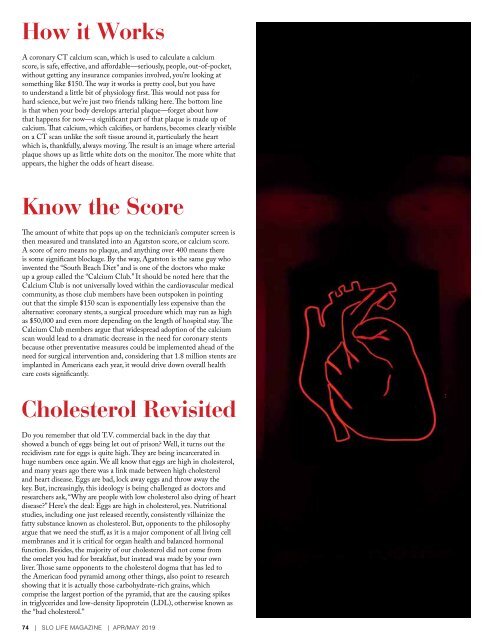SLO LIFE Magazine Apr/May 2019
You also want an ePaper? Increase the reach of your titles
YUMPU automatically turns print PDFs into web optimized ePapers that Google loves.
How it Works<br />
A coronary CT calcium scan, which is used to calculate a calcium<br />
score, is safe, effective, and affordable—seriously, people, out-of-pocket,<br />
without getting any insurance companies involved, you’re looking at<br />
something like $150. The way it works is pretty cool, but you have<br />
to understand a little bit of physiology first. This would not pass for<br />
hard science, but we’re just two friends talking here. The bottom line<br />
is that when your body develops arterial plaque—forget about how<br />
that happens for now—a significant part of that plaque is made up of<br />
calcium. That calcium, which calcifies, or hardens, becomes clearly visible<br />
on a CT scan unlike the soft tissue around it, particularly the heart<br />
which is, thankfully, always moving. The result is an image where arterial<br />
plaque shows up as little white dots on the monitor. The more white that<br />
appears, the higher the odds of heart disease.<br />
Know the Score<br />
The amount of white that pops up on the technician’s computer screen is<br />
then measured and translated into an Agatston score, or calcium score.<br />
A score of zero means no plaque, and anything over 400 means there<br />
is some significant blockage. By the way, Agatston is the same guy who<br />
invented the “South Beach Diet” and is one of the doctors who make<br />
up a group called the “Calcium Club.” It should be noted here that the<br />
Calcium Club is not universally loved within the cardiovascular medical<br />
community, as those club members have been outspoken in pointing<br />
out that the simple $150 scan is exponentially less expensive than the<br />
alternative: coronary stents, a surgical procedure which may run as high<br />
as $50,000 and even more depending on the length of hospital stay. The<br />
Calcium Club members argue that widespread adoption of the calcium<br />
scan would lead to a dramatic decrease in the need for coronary stents<br />
because other preventative measures could be implemented ahead of the<br />
need for surgical intervention and, considering that 1.8 million stents are<br />
implanted in Americans each year, it would drive down overall health<br />
care costs significantly.<br />
Cholesterol Revisited<br />
Do you remember that old T.V. commercial back in the day that<br />
showed a bunch of eggs being let out of prison? Well, it turns out the<br />
recidivism rate for eggs is quite high. They are being incarcerated in<br />
huge numbers once again. We all know that eggs are high in cholesterol,<br />
and many years ago there was a link made between high cholesterol<br />
and heart disease. Eggs are bad, lock away eggs and throw away the<br />
key. But, increasingly, this ideology is being challenged as doctors and<br />
researchers ask, “Why are people with low cholesterol also dying of heart<br />
disease?” Here’s the deal: Eggs are high in cholesterol, yes. Nutritional<br />
studies, including one just released recently, consistently villainize the<br />
fatty substance known as cholesterol. But, opponents to the philosophy<br />
argue that we need the stuff, as it is a major component of all living cell<br />
membranes and it is critical for organ health and balanced hormonal<br />
function. Besides, the majority of our cholesterol did not come from<br />
the omelet you had for breakfast, but instead was made by your own<br />
liver. Those same opponents to the cholesterol dogma that has led to<br />
the American food pyramid among other things, also point to research<br />
showing that it is actually those carbohydrate-rich grains, which<br />
comprise the largest portion of the pyramid, that are the causing spikes<br />
in triglycerides and low-density lipoprotein (LDL), otherwise known as<br />
the “bad cholesterol.”<br />
74 | <strong>SLO</strong> <strong>LIFE</strong> MAGAZINE | APR/MAY <strong>2019</strong>


















